Trying to stop Hitler
The following abbreviations are used in the article: IN - military district, GSh - General base, SOBOVO - Western Special VO, Spacecraft - Red Army, Cova - Kiev Special VO, NCOs - People's Commissariat of Defense, OdVO - Odessa VO, Pribovo - Baltic special VO, Goals Difference - intelligence materials, RU - intelligence department of the General Staff, sd - rifle division, SCWO - North Caucasian VO.
In the previous part the events that took place in the USSR in March - April 1941 of the year are considered, from which it follows that the leadership of the spacecraft and the country did not expect a war with Germany in the near future (in May - June). This follows from the fact that many measures for the recruitment of troops with equipment and reinforcement of armor tanks posted for the period from July 1 to the end of the year. At the same time, in military planning, tank and motorized divisions are considered full-fledged.
World events
The leadership of the spacecraft and the Soviet Union knew about the inevitability of a war with Germany, but believed that the beginning of the war would be associated with the outcome of future negotiations.
The RM has repeatedly said that Germany's attack on the USSR will occur after the defeat of England or the achievement of peace with her. Therefore, the intelligence paid special attention to tracing Germany's contacts with Britain and the United States. In different countries, the German military and officials say the same thing: a war with the USSR is a last resort if negotiations are not successful. In the course of negotiations, ultimatum demands may be put forward.
There were also other reports in which, among the reliable information, there was disinformation. Data that was not always confirmed and could raise doubts about the sources in the future.
An example is the anti-fascist organization "Red Chapel" (this name of the organization will be given later). In early March, they received information that the Germans would attack the Soviet Union in the spring. Later, the RM arrives with the date of the attack on April 15, then on May 20. Now we understand that this was due to the outbreak of the war in the Balkans. But the leadership of the USSR did not know about this. It has seen messages with deadlines that have not been confirmed from time to time ...
On June 11, the Republic of Moldova received from the "Red Capella" that the issue of an attack on the USSR had been resolved, but no details were given in the message.
Could such information be believed if the rate of concentration of German troops at this time is sharply reduced? ..
April 1941 years... Soviet residencies in Europe were ordered to intensify their work, bringing it in line with wartime conditions.
The British ambassador to Moscow is confident that Germany will present an ultimatum to the Soviet Union.
In the spring of 1941, German submarines intensified the war on British supply routes. Losses of merchant ships reach their maximum in April. Perhaps it was pressure on the British government before Hess's arrival?
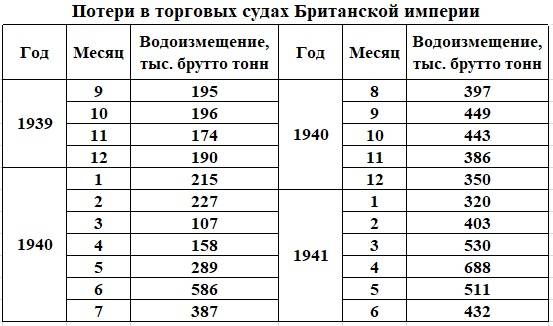
Roosevelt announced that "Defense zone" expands to 25 degrees west longitude. In this zone, from April 24, the American fleet, together with the British fleet will begin escorting British merchant ships.
13 April unexpectedly for Germany, the Soviet-Japanese Treaty of Neutrality was signed, which was ratified on April 25.
18 April The British ambassador handed our government a memorandum stating that England's defeat in the war would entail an attack by Germany on the USSR in alliance with defeated Britain and some circles from the United States.
21 April the Resolution of the Council of People's Commissars was issued, agreed with the Politburo of the Central Committee of the All-Union Communist Party (Bolsheviks), on the construction of two special-purpose shelters on the territory of the Moscow Kremlin. One of them should be handed over on September 1, and the second - on March 1.03.1942, XNUMX.
NKGB note:
“Below is a summary of my impressions of the state of Soviet-German relations in the context of recent events: ... the military ... are convinced that war is inevitable, but they yearn for a postponement at least until winter ...
The most powerful counterbalance is the fear that we can conclude a separate peace on condition that the Germans evacuate the territory they occupied in Western Europe and give Hitler a free hand in the East ... "
5, 9 и 12 May the USSR ambassador to Germany meets in Moscow with the German ambassador. At the meetings, the issue of possible Soviet-German negotiations is being discussed.
6 May R. Sorge informs Moscow that Hitler will decide on a war with the USSR "Either already in May, or after the war with England".
10 May the strongest German raid was carried out aviation to London. Hess flies to England.
11 May ended the massive German air raids on England. Probably to facilitate the fulfillment of the mission by Hess.
13 May The British ambassador proposed to dissolve the rumor about the conclusion of the Anglo-German peace with the mediation of Hess. In the 20th of May, the RM comes to the effect that negotiations with Hess are continuing.
State Secretary of the German Foreign Ministry Weizsacker wrote after the war:
What did it consist of?
In persuading Britain to conclude a "peace" with Germany and to take joint actions against the Soviet Union ...
What the British said to him in response is unknown, but the materials on the Hess case are still closed.
USSR Ambassador to England I. M. Maisky wrote in my diary:
Beaverbrook replied without hesitation:
“Hess is Hitler's emissary. Hess must have thought that as soon as he laid out his plan, all these dukes would run to the king, topple Churchill and create a "reasonable government" ... Idiot!
The RM arrives in Moscow about the actions of the British intelligence, aimed at provoking a clash between Germany and the USSR. British intelligence is spreading rumors that "The Soviet Union intends to immediately undertake further aggressive military action as soon as Germany is drawn into major operations.".
In the previous part, it was shown that the German military leadership did not experience fear of the spacecraft invasion.
14 May The NKGB reported:
First, Germany will present an ultimatum to the Soviet Union demanding wider exports to Germany and the abandonment of communist propaganda ...
The presentation of the ultimatum will be preceded by a "war of nerves" in order to demoralize the USSR ...
15 June a version was circulated through diplomatic channels that by early July Germany would clarify relations with the USSR by presenting certain requirements.
19 May our scout Costa reported: "From the information collected, it can be established that at present Germany has concentrated 120 divisions in Poland, and by the end of June there will be 200 divisions on the Soviet border ..."
The number of German divisions near our border at the end of June in the message coincides with the number considered by the General Staff in March-April 1941 in the event of a war with Germany.
Similar information comes from the "Lyceum" double agent:
“Germany has now concentrated about 160-200 divisions on the Soviet border ...
A war between the Soviet Union and Germany is unlikely ... The German military forces assembled on the border must show the Soviet Union determination ...
Hitler expects that Stalin will become more accommodating in this regard and stop all sorts of intrigues against Germany, and most importantly, will provide more goods, especially oil ...
A. P. Sudoplatov wrote that Moscow suspected (or knew) that the "Lyceist" was a double agent.
26 May our intelligence obtained a document from the British Foreign Ministry, which dealt with the Soviet-German negotiations.
On the same day, the NKGB reported: «[USSR Ambassador to Germany - approx. auth.] is still in Moscow, where he could deliver from Berlin the expected German demands ... "
27 May Roosevelt stated:
US policy is to actively resist attempts to establish German control over the seas ...
The United States will provide all possible assistance to England and those countries that by force weapons resist Germany ...
In mid-May, Germany was notified of Stalin's opportunity to arrive in Berlin for negotiations. At the same time, information about the USSR's intention to defend its interests was communicated to Berlin through various channels.
In May-June, rumors were initiated: about the preparation of the Soviet Air Force to strike at Berlin in an attack by Germany, about the possible use of chemical and bacteriological weapons. The government of the Soviet Union is trying to involve Germany in negotiations.
In May-June, Secretary of State Meissner told our ambassador that Hitler was preparing to take an important step towards strengthening relations with the USSR, hinting at his desire to meet with Stalin.
31 May NKGB reports: "President [Finland - approx. auth.] at a government meeting, he said ... some negotiations are underway between the USSR and Germany ... "
From the diary of Gebels (31.5.41 G.):
Churchill:
Using them as a threat, they are likely to demand concessions that could prove very dangerous to us. If the Russians refuse, the Germans will act ...
An order was sent from London to the commander-in-chief in the Middle East and India:
R. Sorge (November 1.6.41, XNUMX): "The expectation of the start of the German-Soviet war around June 15 is based ... on the information that Lieutenant Colonel Scholl brought with him from Berlin, from where he left on May 6 ..."
Message Sir Sargent:
On June 5, this information was reported to Stalin, Molotov and Beria.
Churchill:
It is possible that Germany wants to remove from its eastern border the potential threat of the increasingly powerful Soviet armed forces.
The management did not yet consider it possible to say whether the result would be a war or an agreement ...
Special message from Berlin (9 June):
Germany will present the Soviet Union with a demand to provide the Germans with economic leadership in the Ukraine, to increase the supply of grain and oil, as well as to use the Soviet navy, primarily submarines, against England ...
May Day parade
German industrialists who came to the USSR accompanied by Abwehr employees were shown the factories, which made a great impression on them.
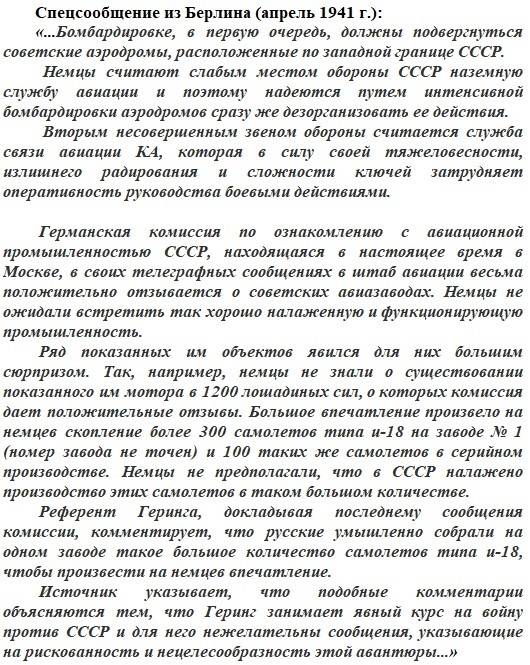
However, from the incoming reports, the German military command drew an unexpected conclusion: "We must move immediately, otherwise the risk of attack will be too great."... Therefore, increased attention was paid to the observation of the parade. It was expected that, given such a tense situation, Russia would show new equipment on it. Schellenberg was sent to Moscow in addition to the office of the military attaché.
On April 25, a telephone conversation was recorded between the German military attaché General Köstering and his deputy, Colonel Krebs: “Krebs: They still don't notice that we are preparing for war. Have you seen what troops arrive at the parade? .. "
Our leadership noticed that the Nazis were preparing for war. But the leadership did not have unequivocal answers to the questions: "When will the war start?", "How will it start?"
Our intelligence officer at the German embassy G. Kegel wrote:
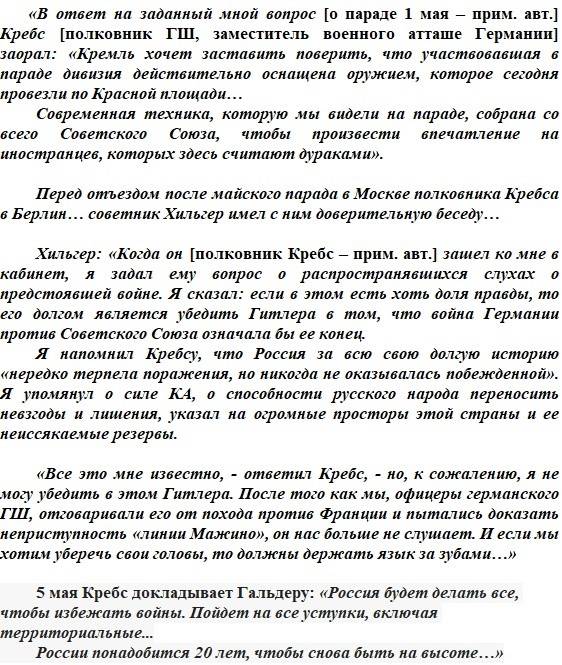
The air part of the parade was attended by modern planes of the Soviet Air Force: MiG-3 and Pe-2. It is unlikely that the position of the leadership of the Wehrmacht and Hitler would have been influenced by the display of numerous T-34 and KV-1 tanks. In addition, the leadership of the spacecraft "knew" that the Germans had heavy tanks and divisions of heavy tanks.
On May 5, in front of graduates of military academies, Stalin makes a speech in which he notes the presence of 300 formations in the spacecraft and reveals the number of motorized and tank divisions.
On May 13, by order of the People's Commissar of Defense, graduates of command and military-political schools were sent to the troops. In some schools, graduation took place in the month of April.
In KOVO, several military infantry schools, after early graduation, are relocated to the inner districts (Belotserkovskoe, Vinnitsa, Zhitomir, Cherkasskoe and Lvovskoe (in 1940 - in Ovruch, and in April 1941 - further to the East)). In other VOs, the redeployment of schools did not take place before the start of the war.
On May 14, the head of the Main Armored Directorate, Ya. N. Fedorenko, submitted a Memorandum to the People's Commissar of Defense stating that due to the incomplete provision of mechanized corps with tanks by state, they:
It was proposed to allocate 80 machine guns, 24 76-mm and 18 45-mm guns to the tank regiment. For the transportation of personnel and weapons, it was required to allocate 1200 ZIS vehicles and 1500 GAZ vehicles.
Attached to the note was a statement of the distribution of weapons and vehicles by mechanized corps: 19th, 16th, 24th (KOVO), 20th, 17th, 13th (ZAPOVO), 2nd, 18th (OdVO ), 3rd, 12th (PribOVO), 10th (Leningrad VO), 23rd (Oryol VO), 25th (Kharkov VO), 26th (SKVO), 27th (Central Asian VO ) and 21st (Moscow VO). The note was approved by the People's Commissar of Defense on May 15.
On May 16, the head of the General Staff sent directives to the districts on the implementation of this event by July 1, which followed:
Cannons and machine guns were in the warehouses and could have entered the regiments by July 1. The problem was different: there was no free vehicle in the spacecraft. There was a shortage of transport in mechanized corps, in anti-tank artillery brigades and in rifle divisions. And no one determined the priority of the arrival of transport in the formations, since the war was supposed to take place sometime in the future ...
It seems that Fedorenko's proposal was motivated by the fact that the weapons and personnel of the mechanized corps were kept and not transferred to other formations. It is possible that this issue was discussed at the time. It is unlikely that the proposed event could change something in the border battles. Most likely more weapons would remain at the border ...
A similar situation was with weak airfield divisions after the Battle of Stalingrad, when Goering also did not want to transfer the Air Force personnel to the Wehrmacht.
The problems of the spacecraft were different: in the weak training of the command of all levels, in the execution of orders that had lost their relevance (lack of reasonable initiative), in the low saturation of mechanized corps with infantry, in an insufficient number of transport, in the absence of a number of extremely necessary ammunition, in problems with communication, in weak intelligence work, because of which the troops at the border were not rationally located in the military.
On May 16, the border districts were instructed to accelerate the construction of fortified areas on the new border. The General Staff allows the covering troops to keep ammunition in tanks.
On May 27, in order to increase the combat readiness of the headquarters for command and control, the commanders of the western districts received an order from the People's Commissar of Defense to start building command posts for the fronts and complete it by July 30.
Change of plans of the General Staff
In accordance with the plan of the General Staff on strategic deployment of 11.03.1941/XNUMX/XNUMX, in April, the Directive on the development of District Operational Deployment Plan.
Since the directive lists Japan as one of the possible opponents of the USSR, the document was prepared before the conclusion of the Soviet-Japanese treaty. The directive repeats information from the plans of the General Staff of March 11 that Germany "Will be able to send up to 200 divisions against our borders, of which up to 165 infantry, 20 tank and 15 motorized"... Based on the indicated number of divisions, the General Staff at this time develops its plans.
After the conclusion of the Soviet-Japanese treaty, the General Staff decided that the situation in the Far East and Transbaikalia was becoming less tense. Therefore, before the war, it was decided to transfer part of the troops to the European part of the USSR from these territories.
In April, a decision was made to form anti-tank artillery brigades and airborne corps. The personnel of 11 rifle divisions will be used to form these formations.
On April 26 (the day after the ratification of the treaty), several directives were sent on the redeployment of troops to the west:
- from the Far Eastern Front - 211st and 212nd airborne brigades. It was also necessary to prepare for dispatch in the second half of May, the management of the 31st Rifle Corps, 21st and 66th SD;
- from the Siberian VO - 201st and 225th rifle divisions;
- from the Ural VO - 203rd and 223rd SD;
- to prepare the 5th mechanized corps and the 32nd rifle corps for dispatch in the Zabaikalsky VO.
On April 29, a directive was sent to the Moscow VO on the direction of the 224th and 231st SDs to ZAPOVO.
Probably, directives on redeployment to the west were also sent in April: 207th Rifle Division from North Caucasus Military District, 230th Rifle Division from Kharkiv VO, 234th Rifle Division from Privolzhsky VO, 211st and 226th Rifle Division from Oryol VO. The division needed to be staffed with fully and well-trained personnel. According to the plans of the General Staff, at this time the 5th Mechanized and 32nd Rifle Corps, on additional instructions, should be sent to the Voronezh Region.
In mid-May, the Operations Directorate of the General Staff is developing a new document "On considerations for a plan for the strategic deployment of the armed forces of the Soviet Union in the event of a war with Germany and its allies." A map with a note is attached to the document: "Major General Vasilevsky 15.5.41".
On June 30.06.2021, 15.05.41, the following documents were submitted: "The scheme of deployment of the strategic forces of the USSR" and "The scheme of the balance of forces" (annex to the memorandum of the People's Commissar of Defense S.K. Timoshenko and Chief of the General Staff G.K. wars with Germany and its allies from XNUMX). It was said that the head of the Main Operations Directorate of the General Staff N.F. Vatutin and his deputy A.M. Vasilevsky worked on the scheme.
It was noted that
How can the diagram reflect the correct opinion of the General Staff about the German plans, if the intelligence data at that time greatly distorted the distribution of German troops along the border?
Historian S. L. Chekunov Online "Militera" wrote:
[On the map - approx. auth.] all movements are documented, relocation points are indicated ...
The May project did not imply an operation in the foreseeable future, it only recorded the current situation and gave proposals for changing the planning ...
When carrying out similar planning work at the General Staff in February-March, a much larger number of documents were prepared.
S. L. Chekunov explained the lack of registration number and signatures on the document:
In addition, there are documents transferred personally between executors of different departments, which were also not recorded in the accounting journals ...
The absence of an approving signature does not mean absolutely anything. The approval could be done in several ways.
So, for example, on one of the district deployment plans for 1941 there is an inscription: the plan was reported during a personal visit.
The plan as a whole was approved by Comrade Tymoshenko, taking into account the following remarks ...
However, there is no signature of Tymoshenko's autograph in place of the "sealed" signature, that is, Comrade Tymoshenko verbally approved ...
There are pencil edits in the document. According to one version, the document was developed by A.M. Vasilevsky and corrected by the head of the Operations Directorate of the General Staff and the 1st Deputy Chief of the General Staff N.F. Vatutin.
On the first page of the document there is a link to the information (summary) of RU from 15.05.41 about German divisions near our border. Therefore, the textual part of the document could be prepared only after May 15th. The document indicates the total number of German divisions (284) and sets out the assumptions of the specialists of the General Staff about the directions of the attacks of the German troops. The number of German divisions (180), deployed by Germany in the event of a war with the USSR, has been clarified. There are 180 divisions operating in the General Staff a little more than a month before the start of the war. None of them can imagine that having 124-125 divisions, the German command will unleash a war with us. The specialists of the General Staff reflected their opinion that, most likely, the enemy grouping would be deployed according to the Southern option.
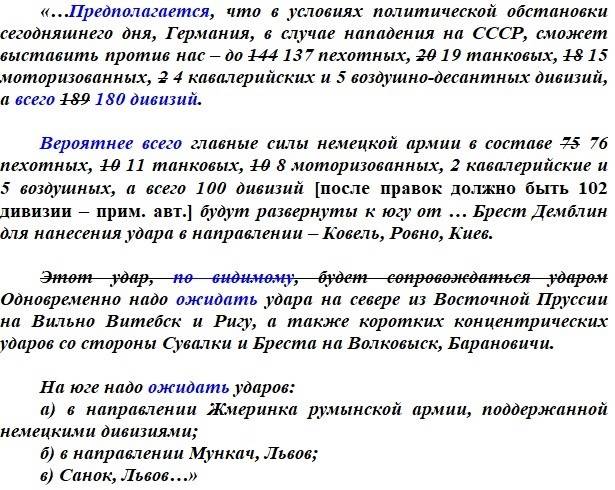
The General Staff assumes that five airborne divisions will appear at the border before the German attack. It was German disinformation. The same as the divisions of heavy tanks ... In vain reconnaissance tried to track these divisions near the border ...
The document indicates the location of the remaining 104 divisions:
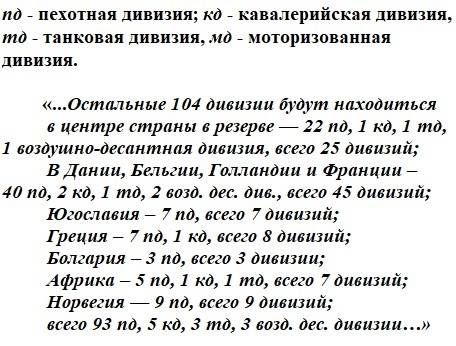
Romania is not included in the list.
What's the catch?
RU considers divisions concentrated at our border only on the border territory of Romania (in Moldova and Northern Dobrudja).
According to reconnaissance data, as of May 15, six more German divisions are located in the central part of Romania (at a distance of up to 250 km from the border), which are not included in the calculation of the formations concentrated at our border.
The document also reflects the point of view of the General Staff, according to which the entire German grouping on the territory of Romania is intended for a war with the USSR.
And rightly so.
In East Prussia, a grouping concentrated at a distance of 300–400 km from the border is considered to be concentrated at the border. In Romania, however, a grouping 200–250 km away from the border is not considered troops intended for an attack on the USSR. After the start of the war, RU will consider the entire grouping of German troops in Romania intended for the war with the USSR.
Below are data on the change in the General Staff of the number of SC troops in directions as of March 11 and May 15, 1941. In the figure, the number of formations of the Western direction (as of May 15) includes the reserve troops of the main command, concentrated behind the Western and South-Western fronts.
After the conclusion of an agreement with Japan, the situation in the zones of responsibility of the Far Eastern Front and the Trans-Baikal Military District became less dangerous. Therefore, in preparation for repelling the German attack, it is planned to transfer ten divisions from these territories, including 4 - tank, 5 - motorized and motorized rifle.
Information began to arrive about the presence of German troops on the territory of Norway, and therefore the grouping of the Leningrad Military District was being strengthened: by 3 tank and 2 motorized divisions.
The grouping of the Transcaucasian Military District has slightly increased, from which the mechanized corps is planned to be sent to the west.
The beginning of the redeployment of troops
The official point of view (for example, in the book "1941 - Lessons and Conclusions") is as follows: "From May 13 to May 22, the General Staff received orders to begin the advancement of three armies to the western border (22, 21 and 16) ... Along with this, a schedule was developed for the transfer from the North Caucasus Military District to the Cherkassy region, Belaya Tserkov of the 19th Army ..."
In one of articles the opinion of historians about the beginning of the redeployment of troops to the western borders in May 1941 has already been considered. Historians noted that in May only one 19th army was nominated, and the 16th went to the Transcaucasus (somewhat later) ...
Consider where the 19th Army advanced and why did it begin to advance in general?
At the end of April and the beginning of May, the RM received information about a possible German attack on the Soviet Union in mid-May or at its end. Below is one of these messages:
“... According to the data of a German officer from Hitler's headquarters, obtained through a third person, the Germans are preparing an invasion of the USSR by May 3. The invasion is supposed to be carried out from the directions: Finland, the Baltic States and Romania ...
At the same time, the RM received an increase in the number of German divisions at our border.
For simplicity, the author will consider the concentration of German divisions against the troops of the PribOVO and ZAPOVO, as well as against the KOVO and ODVO. In this case, you can see how the accumulation of German troops took place in the directions corresponding to the Northern or Southern option.
One point should be clarified.
In the border area of Romania, our intelligence monitored a fairly large German group. On May 31, it consisted of 17 divisions. The figure below shows a fragment of the KOVO headquarters map, already familiar from the intelligence articles, with the situation starting from June 19, 1941.
It can be seen that most of the German grouping is concentrated in the area of responsibility of the KOVO: on its left flank. In the area of responsibility of the ODVO there are six divisions. Therefore, our grouping on the territory of the OdVO did not increase before the start of the war. In addition, on the territory of the OdVO there were two corps of the reserve of the main command: the 2nd mechanized and 7th rifle.
It should be noted that the presence of a large German grouping on the southern flank of the KOVO was also noted in the RM of the NKVD border troops, which confirms the imitation of these formations by the German command.
Help from the NKVD of the USSR (prepared after May 24):
In April-May [1941 - approx. ed.] in Romania concentrated up to 12-18 divisions of German troops, of which: 7 md and up to 2 td ... The largest concentration of German troops is noted in the area of Dorohoi, Redeutsi, Botosani. On May 21-24, up to 6 md, 1 td and 2 pd were located in this area ...
The certificate refers to the border area. The settlements indicated in the document are shown in the figure above.
In a small area of territory on the left flank of the KO, a German grouping of 9 divisions is concentrated, of which only two are infantry. In fact, as of June 22, there were only six German infantry divisions throughout Romania, one of which was still unloading.
The figures below show data on the change in the number of German troops at the border in different directions and on the change in their average concentration rate. When building dependencies, we used the PM from February 1, March 11, 4 и 26 April, 5, 15 и 31 May.
Two dependencies for each of the directions characterize the minimum and maximum number of divisions indicated in the RM.
The figure shows that in the period from April 26 to May 5, there is a sharp increase in the number of divisions in the areas of responsibility of the KOVO and ODVO. According to unverified intelligence information, up to 56 German divisions may be deployed against the troops of these districts, of which up to 19 divisions in Romania (excluding 6 divisions in the central part of the country). By May 31, reconnaissance discovered a German grouping in Slovakia in the amount of five divisions.
After May 5, the average speed of concentration of enemy formations sharply increases (unverified information from the RM was not taken into account when plotting the graph).
The figure below shows the number of divisions of the 1st and 2nd echelons of the districts, taking into account the combat mechanized corps (1st stage of recruitment). The number of divisions is given in brackets, taking into account the reserves of the districts (also without the mechanized corps of the 2nd stage). Enemy troops are counted in accordance with RM from the RU reports.
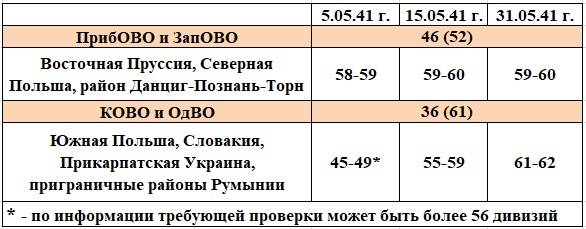
What conclusions can be drawn from the information provided?
The number of German divisions in the PribOVO and ZAPOVO zones of responsibility does not change significantly.
Starting from June 5, in the area of responsibility of the KOVO and ODVO (especially on the southern flank of the KOVO), there has been a sharp increase in the number of German divisions. It is impossible to predict in advance when the speed of concentration of enemy troops will decrease or, conversely, increase even more is impossible.
It could not be ruled out that an increase in the invasion grouping to 100-120 divisions had already begun, as the spacecraft leaders saw it, in the event of a concentration of enemy forces according to the Southern option.
P. A. Sudoplatov wrote about the events on the eve of the war:
Achieving at least a balance of power on the border was the most important direction of the military policy of deterring Hitler from attacking Russia....
By May 15, the grouping of enemy troops could be equal to our grouping in KOVO, and later it could already exceed this grouping.
This is probably why the General Staff decides to start a covert redeployment of part of the troops from the North Caucasus Military District.
On May 13, a telegram arrives at KOVO about the deployment of a rifle corps (34th) with corps units, four 12-thousandth rifle divisions (38th, 129th, 158th, 171st) and 28th mountain rifle division.
Corps units, rifle and mountain rifle divisions will begin to arrive from May 20, and the remaining formations - from June 2-3.
The telegram says that "All formations ... remain part of the North Caucasian Military District and are subordinate to the North Caucasian Military District".
The call-up of the assigned personnel for training in the 28th Mountain Rifle Division was not planned. For one reason or another, the division was not sent to KOVO. On June 22, she is located in the area of Sochi.
There is a mention that the 171st rifle division was in the process of redeployment by the beginning of the war. If this information is correct, then by June 10, only three divisions from the North Caucasus Military District arrived on the territory of KOVO. It is possible that this redeployment did not become critical, since from May 15 the speed of concentration of German divisions decreased. After May 31, the speed of concentration of enemy formations decreased even more.
The figure below shows the deployment locations of four divisions that arrived from the North Caucasus Military District, which were located south of Kiev. The figure additionally indicates the direction of the strike of the German-Romanian troops on Zhmerinka, which is reflected in the document "On considerations for the strategic deployment plan ..."prepared somewhere around May 15th.
The 34th Rifle Corps, as if on purpose, is deployed to cover the capital of Ukraine from a strike from Romania, in which, according to intelligence, the number of German divisions is increasing.
There is conflicting information on the time of the creation of the 19th Army on the Internet. Most often it is posted without links to sources. On the site "Memory of the People" I.S.Konev has been listed as the commander of the 19th Army since 26 June. There are two more dates for the creation of the army (without links): May 29 and June 13.
In the military encyclopedia and in the multivolume "History Of the Great Patriotic War 1941-1945. " indicates that the 19th Army was formed in June 1941. It also talks about the timing of the creation of other armies of the internal districts: the 20th, 21st, 22nd, 24th, 25th and 28th.
There is an order to the troops of the North Caucasus Military District No. 00123 dated 6.6.41, signed by the commander of the district Konev, a member of the Military Council Sheklanov and the chief of staff of the district Zlobin. Another order to the troops of the North Caucasus Military District No. 0125 of 8.6.41 has already been signed by the acting Reuters, Pinchuk and Barmin. Consequently, on June 6-8, the commanding staff of the district (the future army) departed into the operational group of the North Caucasus Military District.
G.K. Zhukov in his memoirs, he quotes the memoirs of the marshal I. Kh.Bagramyan:
It is headed by the commander of the North Caucasus Military District, Lieutenant General I.S.Konev.
A day later, the General Staff warned the district command to prepare to receive and deploy one more - the 16th Army of Lieutenant General M.F. Lukin, which was being transferred from Transbaikalia ...
Consequently, G.K. Zhukov agrees with this interpretation. Therefore, we will take as a basis the memoirs of I. Kh. Baghramyan.
Then, by the arrival of the directive in early June, the 25th Rifle Corps was already subordinate to the SKVO operational group.
On June 6, I.S.Konev signed an order in the district as the commander of the North Caucasian Military District, and on June 8, he signed an order for the district by the acting commander of the troops. Somewhere during this period, I.S.Konev could leave the district for Moscow, meet with the People's Commissar of Defense and arrive at KOVO by June 10.
There are two inaccuracies that can be checked:
- the fifth division (28th mountain rifle division) did not arrive in KOVO and remained in the North Caucasus Military District until the start of the war;
- the location of the 16th Army in KOVO will be determined after June 10.
The 19th Army initially included the 25th and 34th Rifle Corps, the 26th Mechanized Corps, the 38th Rifle Division and a number of separate units. Information about the locations of the 34th Corps formations (including the 38th Infantry Division) was given above.
The 25th Rifle Corps (127th, 134th and 162nd Rifle Divisions), according to the directive of the General Staff of May 13, was to be redeployed to the camps.
The 127th Rifle Division left the Chuguev camps on May 18 (after receiving the enrolled personnel) and arrived at the Rzhishchev camps on the territory of KOVO on June 6-8. On June 10, the division began training. On June 24, she received the remaining enrollment.
The 134th Rifle Division departed from Mariupol for Zolotonosha on the territory of the Kharkov Military District by rail, leaving one regiment (unknown - rifle or artillery) in the camps near Mariupol. Previously, the division was replenished with an assigned composition, called up for a 45-day training camp. Some parts of the division were in Mariupol on June 22. Perhaps we are talking about an abandoned regiment or other parts (subunits) of the division.
162nd rifle division was located near the city of Lubny on the territory of the Kharkov Military District.
Of the three divisions of the 25th Rifle Corps, two were stationed outside KOVO, and by the beginning of the war the corps was concentrated on the territory of KOVO near the city of Korsun.
The 26th mechanized corps was in the North Caucasus Military District until July 1941. As of June 1, the corps had 235 tanks (as of June 22, it is said that there were 184 tanks), of which 87 had a gun. The tanks were badly worn out. Therefore, after the start of the war, the corps as part of the 19th Army was replaced by the 25th mechanized corps (Kharkov VO), in which there were 375 tanks, of which with a gun - 119. At the beginning of the war, the unloading of the 25th mechanized corps was planned in the Cherkassy - Belaya Tserkov area ...
If you look at the map above, you can see that the entire 19th Army was concentrated on the flank of a powerful group that could strike from Romania.
According to the author, the redeployment of the 19th Army troops to the southern flank of KOVO was due to unreliable RM, which included misinformation about the rapidly growing enemy force in Romania.
By June 20, RU estimates the German grouping in Romania at 28-30 divisions, and on the evening of June 22 - at 33-35 divisions, of which 4 are tank and 11 are motorized. This is the largest mobile force on our western border.
According to the RM, which arrived in the spring of 1941, for all variants of military operations, it was said about a strike from Romania. The last such mention took place after May 15. Therefore, this direction in the General Staff is of paramount importance. This is evidenced by the telegram of the 1st Deputy Chief of the General Staff N.F. Vatutin to the commander of the KOVO, sent immediately after the start of the war (at 4:15):
The brigade should be in full readiness to occupy the defense lines in the direction of Novaya Ushitsa, Lipkany ...
The figure below shows the location of the 4th anti-tank artillery brigade and the settlements indicated in the telegram.
The problem was one thing: the General Staff did not take into account that the anti-tank brigade did not have tractors for transporting artillery pieces ... For the General Staff it was a full-fledged formation ...
In the second half of May, the command of the 9th Rifle Corps and the 106th Rifle Division were sent from the North Caucasus Military District to the Crimea. The 32nd Cavalry Division began redeploying from KOVO to the Crimea. The increase in the grouping of troops in the Crimea took place in order to strengthen the defense of the coast from enemy assault forces, which could sail from ports in Romania.
It can be concluded that from the North Caucasus Military District and the Kharkov Military District in May - at the beginning of June, up to six divisions arrived from the internal districts to the territory of the KOVO and OdVO, which is two rifle corps. Information about the full concentration of the 19th Army at the end of May - at the beginning of June is not confirmed. A mech corps from the army before the start of the war was not supposed to be redeployed to KOVO, as it was a corps of the 2nd formation stage or a "non-combat" corps. It is most likely that the two divisions of the 25th Rifle Corps remaining on the territory of the Kharkov District began redeploying to the territory of KOVO after June 12.
To understand how mobile were the rifle divisions that were redeployed to the west, you need to understand their staffing.
Mountain rifle divisions were contained in a peaceful state of 4/140 (8 people). Wartime staff 829 people.
The rifle divisions were contained in peaceful states of 4/120 (5 people) and 864/4 (100 people). The 10/291 wartime staff was 4 people.
The rifle divisions in the interior districts were kept on a staff of 4/120. Also, such divisions were on the territory of PribOVO, ZAPOVO, KOVO, OdVO and Leningrad VO.
In accordance with a government decree, it was allowed to call for fees: 975 people, 870 horses and 57 cars.
The mountain rifle divisions were drafted into 1100 apprentices. The rifle divisions of the state 4/120 conscripted 6 registrants, and in the division of the state 000/4 - 100-1900 people. A total of seven mountain rifle divisions, sixteen rifle divisions of the 2000/4 state and 100 rifle divisions of the 67/4 state, 120 assigned personnel were called up. Another 464 thousand of the assigned staff were sent to other formations and associations.
To bring the rifle division of the 4/120 state to the 4/100 state, 6 men, 000 horses and 1 vehicles were required.
In order to bring 67 rifle divisions to the 4/100 state, it was required to attract 70 350 horses and 17 353 vehicles to the collection. And in accordance with the decree, it is allowed to take from the national economy only 57 horses and 500 cars.
In addition, the number of cars and horses attracted for collection in the formations, where the remaining 337 thousand of the assigned personnel ended up, is unknown. It is also unclear how many horses and vehicles were used for training in the 4/100 State Rifle Divisions and the 4/140 State Mountain Divisions.
Consequently, the 67 rifle divisions of the 4/120 state, which received 6 registrants each, were limited in mobility due to a lack of road and animal transport. And the available amount of transport was sufficient for the training of appointees in permanent camps.
This conclusion is confirmed in the work "Strategic Sketch of the Great Patriotic War of 1941-1945", prepared in 1961, when Marshal BM Zakharov was the chief of the General Staff:
Particularly in a difficult situation were the divisions sent from the inner districts to the west. Having received a mobilization staff and additional weapons, they, as before, were left with the transport assigned to them by the 6-thousandth staff. In case of full mobilization, these divisions left mobile cells in the former deployment areas, which were supposed to send everything that was missing to new areas ...
When official sources talk about Big Training Camps or hidden mobilization, the issue of lack of transport is simply silent ...
The divisions of the 25th Rifle Corps, which went to the camps in the month of May, were of limited mobility. Therefore, the number of artillery pieces and other military equipment of these divisions, which were left at the points of permanent deployment, is unknown. Four divisions from the North Caucasus Military District were nominated with the same limited mobility.
Limited mobile were also six divisions from the Volga and Ural VOs, which began their advance on June 12. Most likely, they took all the weapons with them, but moving it from the unloading stations was already a big problem ...
In June 1941, the 44th Rifle Corps began to move to Minsk, in which rifle divisions were also kept on a staff of 4/120 prior to gathering. After the start of the war, Captain Malkov (commander of the 163rd artillery regiment of the 64th rifle division) said:
At 22.6 at 7 o'clock, they got better at the Smolevichi station, by 17 o'clock they drove up to Minsk, where they just learned about the beginning of hostilities.
The regiment was loaded on the train was understaffed, 50% of the materiel had no traction... There were only shells for the whole regiment 207 pieces. They took all the property with them, that is, bedding, tents.
In this form, they moved to the front. This was the situation throughout the division. She had live ammunition, only a training stock ...
During the period of the battle at the UR, the division received cartridges from the UR sector, and I received a sufficient number of shells for the 76-mm cannon, there were no shells for the 122-mm shells ...
It can be seen that the division did not have enough transport. Therefore, they took with them all the materiel, as they were transported by rail. But the artillery regiment was limited to mobile. Shells with a caliber of more than 76-mm and mortar mines in the warehouses of the UR simply could not be, since this is ammunition for weapons that are not in the fortified area. As well as grenades for arming the UR pulbats and the whole rifle corps.
The rifle corps, which in June went on foot to the front, also left about half of their anti-aircraft and artillery pieces at their permanent deployment points due to lack of transport. But they took educational equipment, bedding, tents and even sports equipment.
After all, no one told them that they were going to fight ...
To be continued ...
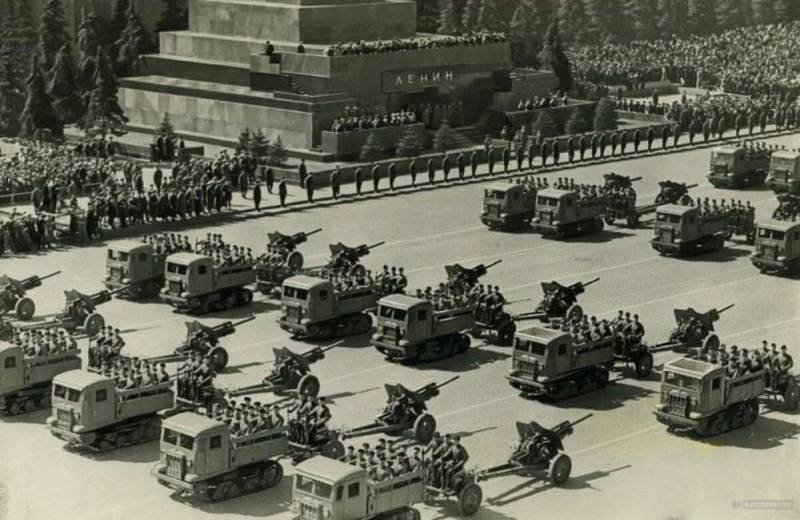
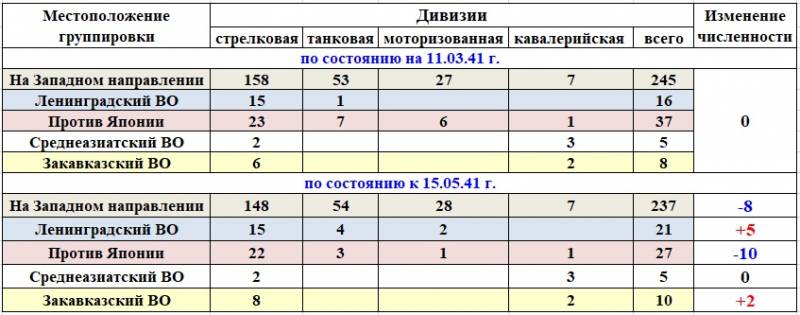
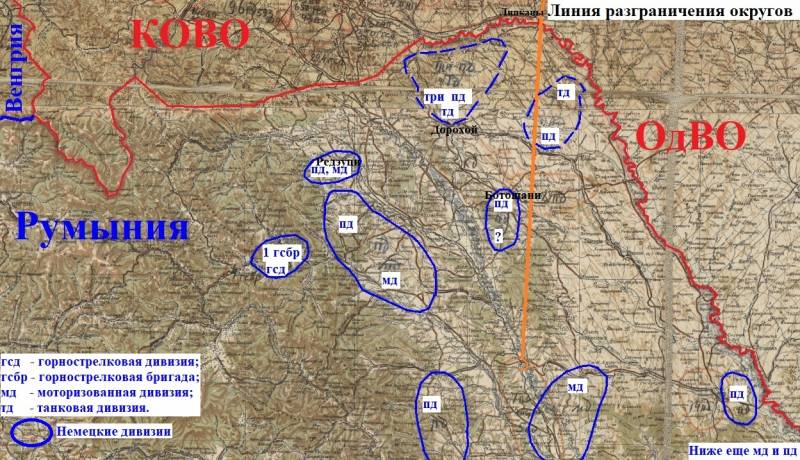
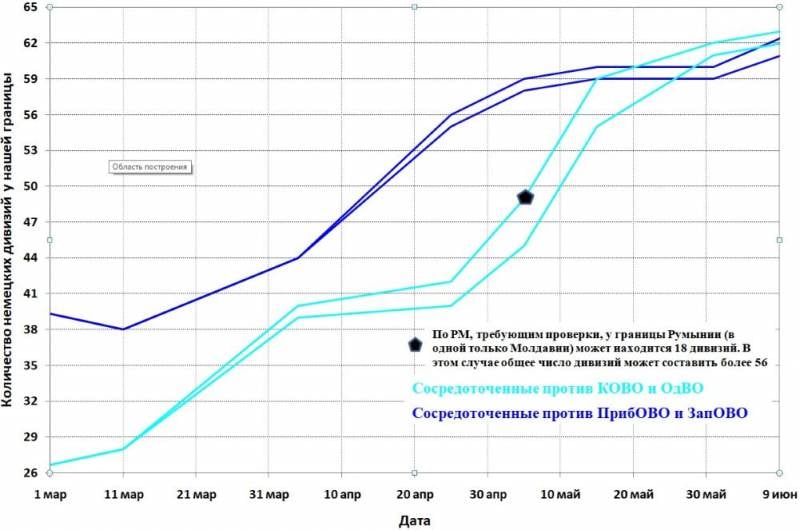
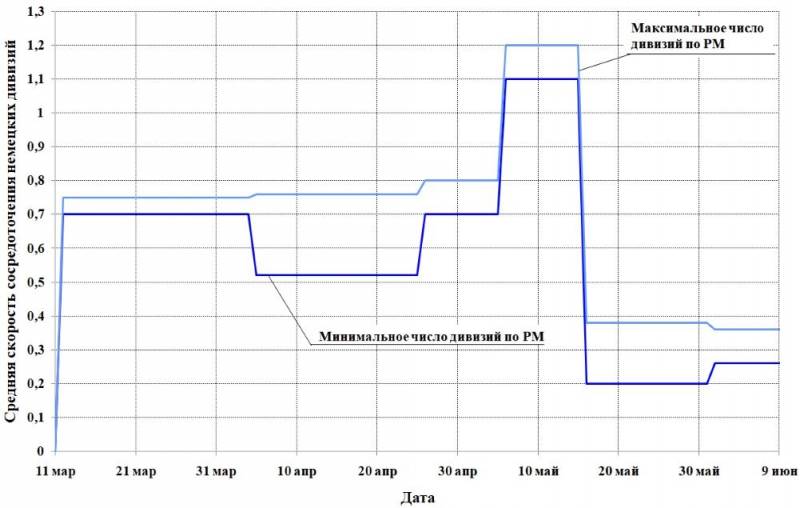
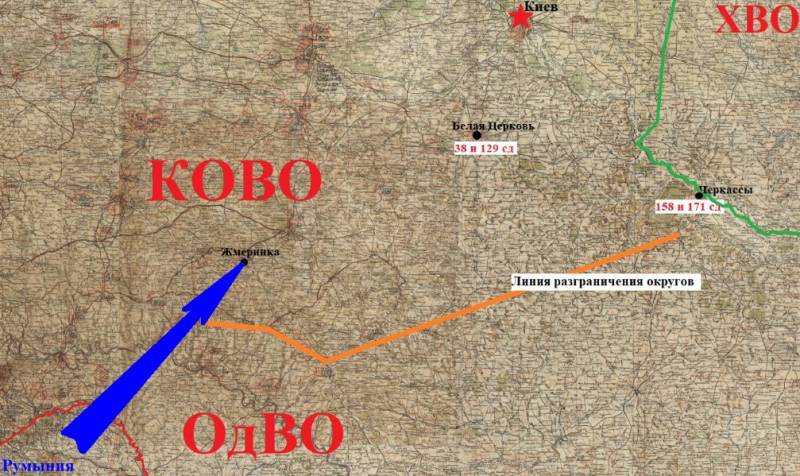
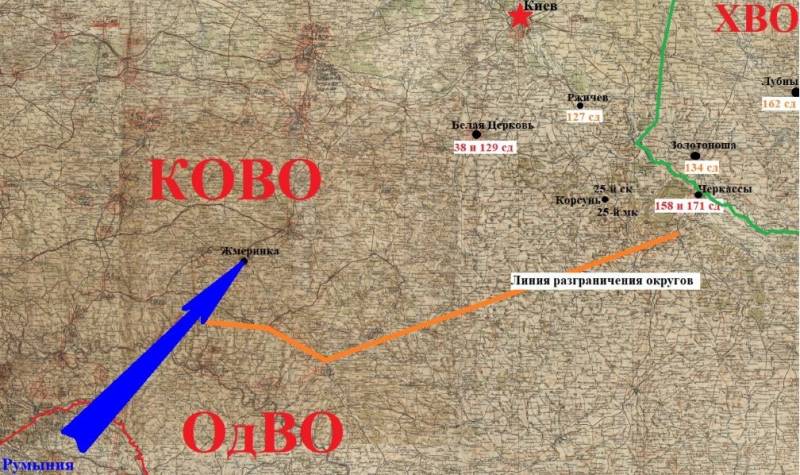
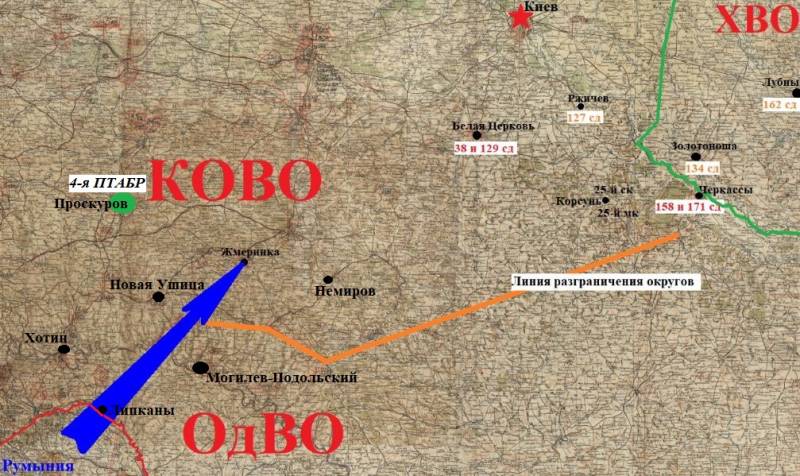
Information